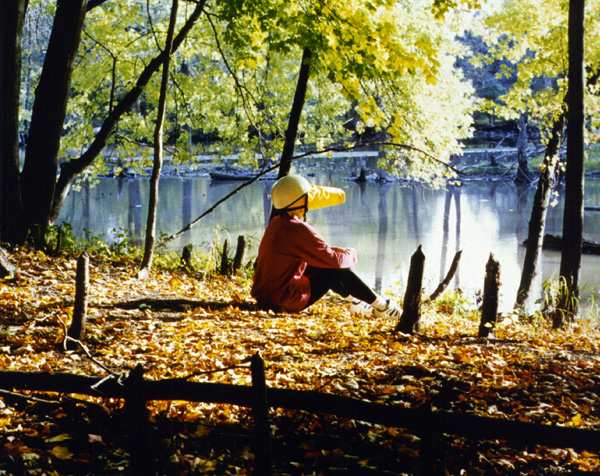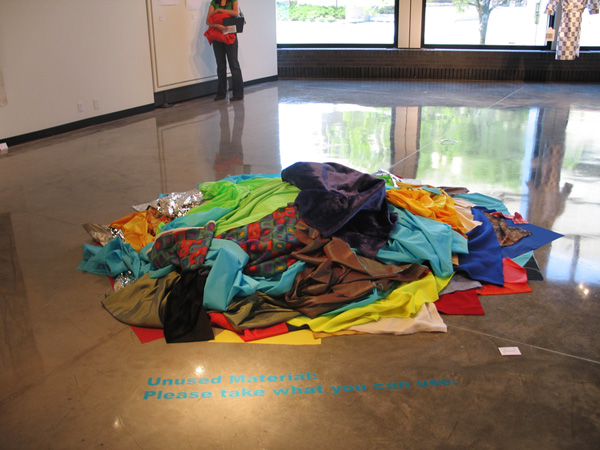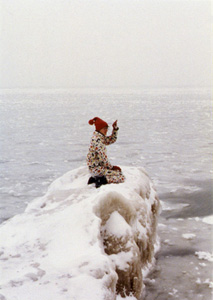Taylor Isaacson, "Interview with Jan Estep," November 17, 2008. Artist Taylor Isaacson questions Jan Estep about her approach to art for an assignment in an art course at UC Berkeley taught by Ginger Wolfe, Fall 2008.
Interview with Jan Estep
Jan Estep, Focus Bonnet, Fall Photograph, 1996, color photograph, size variable, from "Survival Wear".
Taylor Isaacson: Your work ranges from photos to videos to sculpture to interactive work such as Unused Material: Please Take What You Can Use. How do you find your inspiration for such a variety of aesthetics?
Jan Estep: Most of the work originates from the things I am thinking about rather than a specific medium per se; in fact, the ideas lead me to the material choices. It’s clear to me when something is a video project, based on a script or performance idea, with a narrative or through-line that develops through time; or when something needs to be a single image, the documentation of a real place in the world that photography enables or when a digital print will let me work with the image or text in an optimal way; or when something needs to take a more sculptural form or a book form. The medium is chosen to best enhance what the work is about and how I think a viewer might engage with it. I want the focus to be on the ideas and will use whatever materials make the most sense given those ideas.
TI: I’m particularly interested in your work Unused Material: Please Take What You Can Use. I felt a tone of curiosity toward how individuals would react to the piece. Did you intend to investigate human nature and the materialism that’s such a far-reaching aspect of our society today?
Jan Estep, Unused Material: Please Take What You Can Use, 2007, fabrics to be recycled back into use.
JE: I was very excited to see what would happen, how the audience would take me up on the invitation or not. And in that regard it was a social experiment. But I was most inspired by an ecological motive: I had all of this unused material leftover from the “Survival Wear” series, really great fabrics like Polartec, Goretex, Supplex nylon, some lengths of fake fur, and I wanted to get them out of my studio to free up some space. Yet I couldn’t find a local thrift shop that would take so much fabric and didn’t want to throw them in the trash. In mulling over the situation I came up with the idea for the interactive piece; I teach at a university and knew students in particular might be drawn to it. Who could resist free materials? But I was pleasantly surprised that other kinds of people were drawn to the pile: kids, spouses, non-artists. The fabric was colorful, bright, and offered a practical choice: people told me that they were going to make scarves and hats with the remnants they took. One person was going to make a dog bed with the material. The stuff that once had value for me, but which no longer served that purpose, was getting a second life in someone else’s hands. I loved that art could have that direct of an exchange and actually be useful in an obvious way; the viewer walked away with a concrete experience, unused materials were recycled back into circulation, and the trash heap was avoided.
I have a printed map of a hut that the philosopher Ludwig Wittgenstein built in Norway, titled Searching for Ludwig Wittgenstein, Lake Eidsvatnet, Skjolden, Sogn, Norway. During an exhibition, I stack the map on a pedestal and give it away for free. I also sell it at Printed Matter in New York city, but it feels great to be able during an exhibition to give viewers a work they can walk away with, whether they have money to buy something or not. In the case of the Wittgenstein map, I felt I could be generous because an external artist grant paid for the printing. I don’t always have the level of financial support, but I took advantage of it when I could. Both Unused Material and the map subtly undercut materialism, but not in any way that challenges the system altogether. I’m not sure how self-reflexive viewers are when they pick up something “for free,” but I do hope there is a feeling of sharing, a welcome surprise, and a question of art’s use value that come into play. Best of all it lets the works have a life beyond the gallery space.
Exhibition view, Jan Estep, Searching for Ludwig Wittgenstein, Lake Eidsvatnet, Skjolden, Sogn, Norway, 2007, illustrated, folded sheet map, “Out of the Comfort Zone,” Nash Gallery, Minneapolis, September to October 2007.
TI: Taking a step back, your work in “Survival Wear” seems to address the nature of what is man made and manipulated and what is organic and naturally occurring in our world. The photographs of the synthetic materials in nature are compelling for that reason. What did you intend for your audience to gather from the collection?
JE: This was one of my very first series and I was concerned with the issues you describe, particularly the way our experience of nature is mediated by culture and our own projection into and onto the landscape. I was also, as an artist, searching for a creative practice that would take me outside of the studio and into the world; the outfits and props gave me a chance to experience nature in a slightly skewed way. Wearing the sculptures gave me a different perspective, heightened my responses, and shifted the way I interpreted and perceived the environment. I trusted that some of those things translated to the viewer when they in turn viewed the photographs.
At the time I also was trying to find a way to warm up the supposed “coldness” of conceptual art. Adorning the artist in Polartec, which is an incredible technical fabric that keeps the body warm in harsh, frigid climates, was a way to literally prepare me for the coldness. I was working back and forth between the literal and the abstract/metaphorical. I am much less ambivalent today about working conceptually so I no longer feel a need to wrap my art up in fuzzy fabric to keep it warm, but at the time I was thinking a lot about the “temperature” of art and what this reputation of conceptual coldness was all about. The Antarctica project, concurrent with the “Survivor Wear” series, in part also dealt with this idea of coldness and preparing for difficult terrains, but incorporating historical and geographical references. Note that I am describing my perspective about this work; I think the viewer focused more on the nature/culture relationship.
Jan Estep, Escalante, 2001, from "Survivor Wear."
I have always been drawn to the idea of the artist as adventurer: exposing oneself to new situations, preparing for them and learning how to survive them, taking risks (creative risks, intellectual risks), challenging yourself and what you are comfortable with, expanding your horizons. One can understand this idea both from the artist’s perspective and the viewer’s, that art can be a way to create such adventures. I’m not advocating for a macho extreme-sports approach that stresses physical endurance, for the risks can be intellectual, emotional, or social and not necessarily about putting the body in a perilous situation. Whatever the risk or context, the idea of exploring a new territory is key; creativity fueled by exploration and curiosity. Art is a great place to learn about yourself and the world: it’s naturally self-reflexive, philosophical, and critical. Its use of materials to convey information is distinct from any other field and can change the way a person views the chosen subject matter. And sometimes art calls for a comforting fleece jacket.
Jan Estep, Winter Polartec Suit, Iceburg, 1997, from "Survival Wear."
TI: Do you believe that there is one central inspiration to all of your pieces or does each piece have a significant meaning in your life at the time it is created?
JE: While on the surface my immediate concerns change with each project, I do think there are underlying threads that run through all the work. On the surface or overt level I’ve been concerned variously with survival, the natural landscape, and our relationship to our environment (in “Survival Wear” and Desert Maps); discovering uncharted territories and the history of exploration (in the Antarctica project); the relationship between skepticism and optimism (the Antarctica project, Ad Infinitum, the OED “Definitions”); and the myriad ways we use language to name and understand our experience (almost all of the recent projects). And formally my interests, as your first question alludes to, shifts among a wide range of materials from photography, sculpture, embroidery, video, and text. However, underlying most if not all of the projects are a few recurring questions: First, an epistemological and philosophical one: how do we know? That is, what shapes and supports our claims to knowledge? Secondly, a question of judgment and values: what do we take to be real, important, of interest, and how do our individual assumptions determine that? Thirdly, what role does language play in all of this, that is, in understanding our experience of the world? I believe perception and cognition are more closely related than we typically think, and investigating the way images and language relate and inform one another is a way to address that. At the heart of these questions is a basic desire to understand the subject within an expanded field of nature, culture, and the objective physical world. The same questions that drew me to philosophy draw me to make art. Even though the overt subject matter changes, the same mind is responsible for all of the work, so it makes sense to me to see these through-lines.
TI: What piece is your favorite and why?
Focus Bonnet for Nature Walk or Nature Run (side and front views), 1996, helmet, water-resistant nylon, wire, Velcro, 14 by 18 by 10 inches.
JE: That’s a little awkward for me to say, as I can be pretty critical of my own work, but if I had to pick a single piece it would be Focus Bonnet for Nature Walk or Nature Run and the photographs of me wearing the piece. It was a break-through piece for me creatively; it was the first piece in which I understood that my art could be funny, smart, perceptive, use everyday materials, take me outside the usual confines of the art world and studio in the process of making it, and initiate a dialogue with a viewer about ideas that concerned me. I like where language is taking me in the recent projects but Focus Bonnet continues to have sentimental value.





